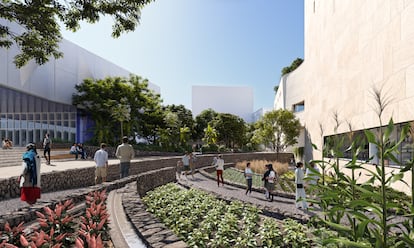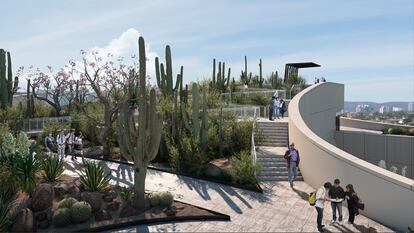Mexico builds largest environmental sciences museum in Latin America
The Museum of Environmental Science — affiliated with the University of Guadalajara — will open its doors in November, after seven years of work that has cost $100 million
The water seeps through the cracks and bare walls, reaching hidden spaces within the strange architectural massif, located in the north of the city of Guadalajara, Mexico. Water, the city and various ecosystems are omnipresent in the design of what will soon become the largest and most avant-garde scientific museum in Latin America.
The Museum of Environmental Science — affiliated with the University of Guadalajara — is a sanctuary for the Anthropocene Epoch, the era in which humans became a kind of geological, destructive force. Its director — Eduardo Santana Castellón, who has Cuban-Puerto Rican roots and training in ecology and ornithology — is an excited guide as he walks EL PAÍS through numerous incomplete rooms. The space consists of nearly 250,000 square feet (75,000 of which are reserved for exhibitions) where scientific knowledge, modern poetry, ancestral culture and a misunderstood city share the same space.

The sweeping work — which is already 80% complete in terms of its physical structure — will gradually open its doors to the public. This delay is due to the budget cuts it has suffered from since the start of the project in February 2016. Coinciding with the Guadalajara International Book Fair (FIL), in November 2023, only the Educational Garden will be open. The ground floor of the gallery will be inaugurated during the FIL in 2024. Subsequently, other parts of the building will follow.
With 12 thematic gardens, seven permanent exhibition galleries, two temporary exhibition halls, four rooms for school workshops, an auditorium and a community development laboratory, the museum is so ambitious that, to some, it seems excessive. And the numbers seem to corroborate this: over one billion Mexican pesos — around $60 million — has been spent on it. This is equivalent to the average annual income of 19,300 humble Mexican households. It’s estimated that this investment will eventually reach $100 million.
Culture and knowledge aren’t cheap, but “this project is designed and intended primarily for the poorest families; it’s a public good that not only seeks to exhibit [objects], but it’s also intended as a tool for these families to discuss with knowledge and with their most pressing daily problems. It’s a space for them,” emphasizes Santana Castellón. The museum will also be a university space, built jointly with the community. It aspires to become a catalyst for socio-ecological transformations in the neighborhood.
More than 100 scientists, teachers, students, artists and local residents shaped the building from stone, gravel, sand, shells and textured concrete, materials “selected for their durability and resonance with vernacular landscapes.” The museum is also a smart building, incorporating the most innovative technology to reduce its energy consumption.
The Museum of Environmental Science in Guadalajara has been set up in a way that distances itself from traditional museums. Instead of dividing up exhibits by ecosystem or relying on taxonomic organization — with exhibits divided into the categories of mammals, birds, reptiles and plants — the scientific heritage is organized by landscapes, which are defined by the cultural use of natural space. Humans have been integrated in a pioneering way. The galleries don’t have walls, “because nature doesn’t have them.” Visitors will find their way according to the colors, shapes, textures, aromas and sound environments.
Snøhetta — a Norwegian-American architectural firm — carried out the design. The architects were inspired by the colonial architecture of the historic city center of Guadalajara, but recognized the limits that nature imposes on the city. Hence, they evoked the process of water erosion that sculpted the Barranca del Río Santiago (the local river’s ravine) — a geographical marker that contains the city to the north and the east. All of this has been done without forgetting the semi-dry plateau of Los Altos de Jalisco, the coniferous and cloud forests of the southwest and the Indigenous Wixárika region of the Sierra Madre Occidental (the western mountain range). “Water erosion gave the building an organic shape and linked its interior patios into a central canyon, which is open to the public,” the museum’s website reads.
In addition to water and ecosystems, the central axis of the structure is the city — the fundamental invention of sapiens, according to museum director Santana Castellón. “The city is where you find the political, economic, military, religious and scientific powers... the powerful urbanite is going to define the future of nature, yet they are the one who least understands the dependence of the city on the ecosystems of those surrounding natural landscapes,” the scientist reflects. “Being able to understand how nature prevents cities from collapsing is the fundamental premise. The military of the Middle Ages knew this when they besieged cities, cut off ecosystem services and caused [the cities] to collapse.”

The museum’s construction was delayed by six years (it was supposed to open at the end of 2017) due to budget conflicts between the country’s second-largest university and the state government of Jalisco, which ceased financial support for the project as a result of the pandemic. However, the death of university rector Raúl Padilla López this past April — a man who was embroiled in fights with both the university’s Cultural Center and the state government — paved the way for dialogue to commence once again. However, there are still more than 140 million pesos — or more than $8 million — that were promised by the state government. The funds still haven’t reached the project. This case — linked to a broader legal issue on university autonomy — is now in the hands of Mexico’s Supreme Court.
Excessive or not, the echo of the project has resonated strongly in the world of architecture.
The museum has been awarded an International Architecture & Design Award in the category of “cultural heritage landscape concept,” awarded by the Architecture & Design Community. It was also honored by the international DNA Paris Design Awards. The gardens of the museum space — which will be made up of western Mexican landscapes — were recognized with the Gold Award, the highest category.
The Museum of Environmental Science in Guadalajara — in its final stage of creation — is endowed with social action, knowledge and sustainable strategies. It’s a museum with a vision — a giant in construction, as well as a representation of the local environments and communities.
Sign up for our weekly newsletter to get more English-language news coverage from EL PAÍS USA Edition
Tu suscripción se está usando en otro dispositivo
¿Quieres añadir otro usuario a tu suscripción?
Si continúas leyendo en este dispositivo, no se podrá leer en el otro.
FlechaTu suscripción se está usando en otro dispositivo y solo puedes acceder a EL PAÍS desde un dispositivo a la vez.
Si quieres compartir tu cuenta, cambia tu suscripción a la modalidad Premium, así podrás añadir otro usuario. Cada uno accederá con su propia cuenta de email, lo que os permitirá personalizar vuestra experiencia en EL PAÍS.
¿Tienes una suscripción de empresa? Accede aquí para contratar más cuentas.
En el caso de no saber quién está usando tu cuenta, te recomendamos cambiar tu contraseña aquí.
Si decides continuar compartiendo tu cuenta, este mensaje se mostrará en tu dispositivo y en el de la otra persona que está usando tu cuenta de forma indefinida, afectando a tu experiencia de lectura. Puedes consultar aquí los términos y condiciones de la suscripción digital.
More information
Archived In
Últimas noticias
Trump followed CIA recommendation to hand power to Delcy Rodríguez due to risk that Machado would not control the army
The Motherwell painting that Franco wanted to hide from view
Mexico seeks to shore up its defenses following US incursion in Venezuela
Hope gives way to uncertainty among Venezuelan exiles in the US after Maduro’s capture
Most viewed
- Alain Aspect, Nobel laureate in physics: ‘Einstein was so smart that he would have had to recognize quantum entanglement’
- Alvin Hellerstein, a 92-year-old judge appointed by Bill Clinton, to preside over Maduro’s trial in New York
- Cuba confirms death of 32 of its citizens in the US attack against Venezuela
- Gilles Lipovetsky: ‘If you want to live better and fall in love, take Prozac, don’t look to philosophy’
- Why oil has been at the center of Venezuela-US conflicts for decades











































